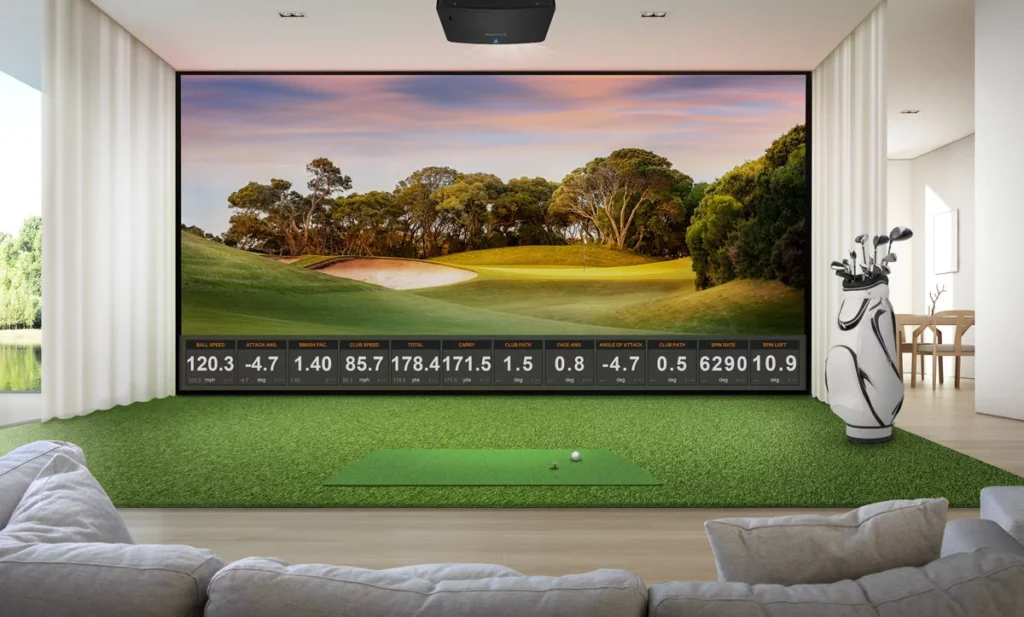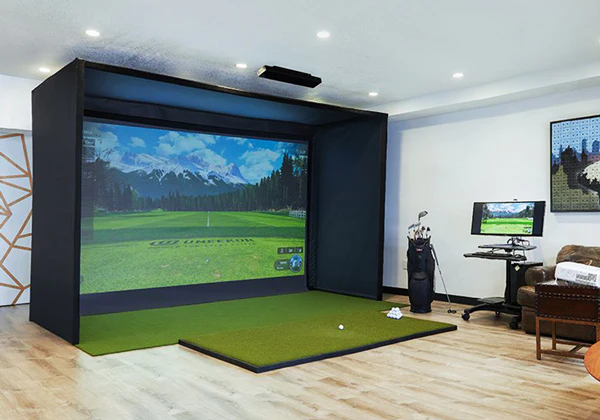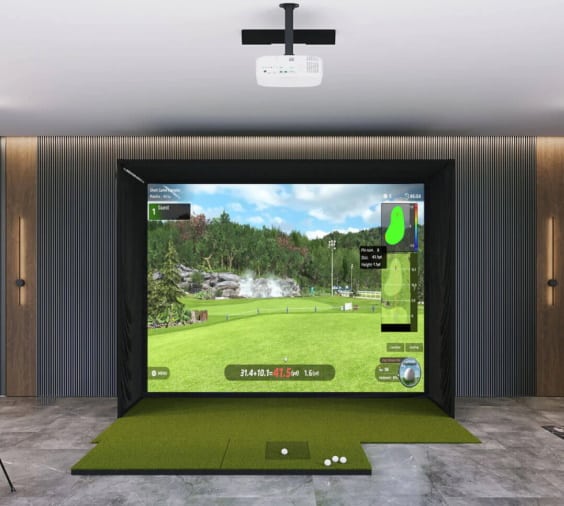How Much is a Golf Simulator?

Imagine this: It’s a rainy Sunday afternoon, and you’re itching to hit the greens. You could wait for the weather to clear up or, thanks to golf simulators, you could bring the greens to your living room. But before you get too excited, you’re probably wondering, “How much does a golf simulator cost anyway?”
I remember when I first asked that question myself. I’d just watched a thrilling golf tournament on TV and thought, “Why not practice my swing at home?” Little did I know that the world of golf simulators had its own price tag adventure in store.
So, if you’ve ever wondered about the cost of turning your garage into a golf haven or transforming your basement into a golfing oasis, you’re in the right place. We’re about to dive into the exciting realm of golf simulators and explore just what it takes to tee off from home.
How Much Does a Golf Simulator Cost?
Here is a breakdown of the different price tiers for golf simulators:
- Entry-level ($1,000-$5,000): Entry-level golf simulators are a good option for golfers on a budget or for those who are just getting started. They typically include a launch monitor, hitting mat, and a golf net. However, they may not have as many features or be as accurate as more expensive models.
- Mid-range ($5,000-$10,000): Mid-range golf simulators offer a good balance of price and performance. They typically include a launch monitor, golf mat, net, projector, and screen. They may also have additional features such as course simulation software and swing analysis tools.
- High-end ($10,000-$25,000): High-end golf simulators offer the most realistic and accurate golf simulation experience. They typically include all of the features of mid-range models, plus additional features such as a larger screen, more powerful projector, and more sophisticated swing analysis tools.
If you are serious about improving your golf game or want to have the most realistic golf simulation experience possible, then a high-end golf simulator is a good investment.
However, if you are on a budget or just getting started, then an entry-level or mid-range golf simulator is a good option.
Types of Golf Simulators

Golf simulators come in various types, each offering unique features and benefits to cater to different budgets and preferences.
Understanding the differences between these types is crucial when considering how much you’re willing to invest in your golf simulator setup. Here, we’ll delve into the three primary categories:
1. Portable Golf Simulators:
Key Features:
- Portability: These simulators are lightweight and easy to set up, making them ideal for small spaces or temporary installations.
- Affordable: Portable simulators are often the most budget-friendly option.
- Simple Setup: They usually require minimal installation and can be quickly assembled.
Benefits:
- Accessibility: Allows golfers to practice virtually anywhere, from their garage to the backyard.
- Cost-Effective: A great entry point for beginners or those on a tight budget.
- Convenience: Easy to store and transport, offering flexibility in usage.
Here is our recommendation:
SkyTrak: The SkyTrak is a great entry-level golf simulator, starting at $1,995. It’s accurate and affordable, and it comes with a variety of features, including a game improvement plan and metal case.

2. Mid-Range Golf Simulators:
Key Features:
- Improved Accuracy: Mid-range simulators often feature more advanced tracking technology for precise shot analysis.
- Larger Screens: They come with larger projection screens or high-definition displays for a more immersive experience.
- Enhanced Software: Typically offer a variety of virtual golf courses and training options.
Benefits:
- Realistic Experience: Delivers a more lifelike golfing experience with enhanced graphics and accuracy.
- Skill Improvement: Suitable for golfers looking to hone their skills and track their progress.
- Variety: Access to a broader range of golf courses and gameplay options.
Here is our recommendation:
Foresight Sports GC3: The Foresight Sports GC3 is another great mid-range golf simulator, starting at $10,495. It’s very accurate and has a variety of features, including a game improvement plan and realistic graphics.

3. High-End Golf Simulators:
Key Features:
- Cutting-Edge Technology: Utilize state-of-the-art tracking systems, often using multiple sensors and cameras.
- Ultra-Realistic Graphics: High-end simulators boast stunning visuals and lifelike course details.
- Customization: Allow for extensive customization of gameplay settings and golf club options.
Benefits:
- Unparalleled Realism: Offers the closest experience to playing on an actual golf course, with precise ball flight and club data.
- Pro-Level Training: Ideal for serious golfers and professionals looking to refine their skills.
- Entertainment Hub: Can serve as a versatile entertainment system for golf enthusiasts and social gatherings.
Understanding the types of golf simulators available helps you align your preferences and budget with the features and benefits that matter most to you.
Whether you opt for a portable, mid-range, or high-end simulator, each type offers a unique golfing experience, making it easier to find the perfect fit for your needs and goals.
Here are a few recommendations:
TrackMan 4: The TrackMan 4 is a top-of-the-line golf simulator, starting at $21,000. It’s extremely accurate and has a variety of features, including a game improvement plan and realistic graphics.

Factors Influencing Price
Let’s dive into the key aspects that play a pivotal role in shaping the cost of a golf simulator. When it comes to investing in this technology, understanding the factors that influence the price is essential.
Here, we’ll explore the primary determinants that impact the overall expense of owning a golf simulator:
1. Simulator Type:
The type of golf simulator you choose has a significant influence on the cost. As previously mentioned, portable, mid-range, and high-end simulators each come with their own price tags.
Portability and simplicity often translate to lower costs, while high-end options with advanced features command a premium.
2. Technology and Accuracy:
The level of technology and accuracy in a simulator is a major cost driver. High-end simulators employ cutting-edge tracking systems, which offer precise ball and club data.
Simulators with multiple sensors and cameras generally come at a higher cost compared to basic models.
3. Screen Size and Quality:
The size and quality of the screen or projection system also contribute to the overall price. Larger, high-definition screens provide a more immersive experience but can increase the cost significantly.
4. Software and Courses:
The range and quality of virtual golf courses and training software available with the simulator affect the price. High-end simulators often provide access to a broader selection of courses and training programs.
5. Additional Features and Accessories:
Additional features like swing analysis, club fitting, or integrated entertainment systems can add to the cost.
Some simulators offer customization options, allowing you to tailor your setup according to your preferences.
6. Installation and Setup:
The complexity of the installation and setup process can impact the overall cost. Some high-end simulators may require professional installation, which comes with an additional expense.
Understanding these factors that influence the cost of a golf simulator empowers you to make an informed decision based on your budget and desired features.
It’s essential to strike a balance between your golfing goals and the investment you’re willing to make to create the ideal simulator setup for your needs.
Cost Breakdown: Unveiling the Expenses

Now, let’s take a closer look at the various components that contribute to the overall cost of acquiring a golf simulator.
A comprehensive cost breakdown is essential for gaining a clear understanding of the financial aspects involved in your golf simulator investment. Here’s a detailed breakdown of the typical expenses:
1. Hardware Costs:
- Golf Simulator Unit: This is the core hardware component and can range from affordable portable units to high-end systems. Prices can vary significantly based on the type and brand you choose.
- Launch Monitor: An essential part of simulator accuracy, launch monitors can be a separate expense, particularly for mid-range and high-end setups.
- Projection Screen or Golf Simulator Enclosure: Depending on the simulator type, you may need a quality projection screen or an enclosure to create an immersive experience.
2. Golf Simulator Software Costs:
- Golf Simulation Software: The software provides access to virtual golf courses and gameplay options. High-quality software often comes at an additional cost.
- Subscription Fees: Some simulator brands may require ongoing subscription fees for software updates and course access.
3. Installation and Setup:
- Professional Installation: High-end simulators, in particular, may require professional installation services, which incur an extra fee.
- Electrical and Connectivity: Ensuring proper electrical wiring and connectivity to your computer or display can involve additional expenses.
4. Optional Accessories:
- Golf Clubs: While not directly related to the simulator itself, some users may choose to invest in golf clubs optimized for simulator play.
- Flooring and Impact Screen Accessories: To protect your space and equipment, you might consider flooring options and additional impact screen accessories.
- Furniture and Seating: Creating a comfortable and functional simulator space may involve costs for seating, tables, and storage.
5. Maintenance and Upkeep:
- Replacement Parts: Over time, certain components, such as projector bulbs or sensors, may need replacement, incurring maintenance costs.
- Software Updates: Some simulator software requires periodic updates, which may involve subscription or one-time fees.
6. Space and Remodeling:
- Space Requirements: Consider any potential remodeling costs if you need to prepare a dedicated space for your simulator.
- Room Renovation: If significant room modifications are necessary, expenses for renovations, insulation, or climate control may apply.
Budget-Friendly Solutions: Golf Simulators on a Dime
For those looking to embrace the world of golf simulators without breaking the bank, there are indeed budget-friendly options that offer a rewarding golfing experience. Let’s explore some cost-effective solutions for golfers who are mindful of their budget:
1. DIY Simulators:
- Build Your Own: Savvy golfers with some technical prowess can opt to construct a DIY golf simulator. This involves repurposing existing equipment, like projectors and screens, and using affordable launch monitors or even free simulation software. While it may require some effort, it’s a budget-conscious way to enjoy simulator golf.
2. Refurbished Simulators:
- Consider Refurbished Units: Refurbished golf simulators, available from reputable sellers, offer a more affordable entry point into the world of simulation. These units have been restored to near-new condition, making them a cost-effective choice for budget-conscious buyers.
3. Entry-Level Brands:
- Explore Affordable Brands: Several simulator manufacturers offer budget-friendly options with basic features. These entry-level simulators are often more accessible in terms of pricing and can still provide a satisfying golf experience for beginners and casual golfers.
4. Software-Only Solutions:
- Software-Only Packages: Some companies offer standalone golf simulation software that you can run on your computer. Paired with an affordable launch monitor or even just a net, this can be a low-cost way to enjoy simulated golf.
5. Simulators for Small Spaces:
- Compact and Portable Units: If you have limited space or are on a tight budget, consider compact and portable simulators. These smaller setups may not offer the same level of immersion as larger systems but can be a great starting point for practice.
While these budget-friendly options may come with some trade-offs in terms of features and realism, they make golf simulation accessible to a wider range of enthusiasts.
Whether you’re looking to build your own setup or explore affordable brands, there’s a budget-friendly solution that can help you enjoy the benefits of simulator golf without straining your finances.
Mid-Range Golf Simulators: Balancing Features and Cost
In the quest for the ideal golf simulator setup, the mid-range category offers a compelling balance between features and cost. Here, we delve into mid-range golf simulators, exploring the advantages of investing a bit more in your simulator experience:
1. Enhanced Realism:
- Mid-range simulators often excel in delivering a more realistic golfing experience compared to budget options. Advanced tracking technology and more accurate data capture contribute to a lifelike feel during gameplay.
2. Improved Graphics and Display:
- A noticeable upgrade in mid-range simulators is the quality of graphics and display. Larger, high-definition screens or projectors provide a more immersive and visually appealing experience.
3. Wider Course Selection:
- Mid-range simulators typically offer a broader selection of virtual golf courses and gameplay options. This variety allows golfers to explore a wide range of challenges and scenarios.
4. More Comprehensive Data:
- With mid-range simulators, you can expect more detailed and precise data feedback on your swing, clubhead speed, ball spin, and other vital metrics. This information is valuable for both practice and improvement.
5. Durability and Longevity:
- Investing a bit more in a mid-range simulator often means acquiring a more durable and robust system. This translates to a longer lifespan and less frequent need for replacement or maintenance.
6. Pro-Level Training:
- Serious golfers and those aiming to elevate their game benefit from the advanced training features found in mid-range simulators. These may include club fitting, swing analysis, and custom practice modes.
7. Social and Entertainment Features:
- Many mid-range simulators incorporate social and entertainment elements, making them suitable for group play or gatherings. These features add to the overall enjoyment of simulator golf.
While mid-range golf simulators come at a higher initial cost than budget options, they offer a significant leap in terms of realism, features, and versatility.
Golfers seeking a more immersive experience and those committed to enhancing their skills often find the investment in a mid-range simulator to be a rewarding choice.
It’s a sweet spot that combines affordability with a range of desirable features, making it a popular choice for avid golfers looking for an exceptional simulator experience.
High-End Golf Simulators

For golf enthusiasts who demand nothing but the best, high-end golf simulators represent the pinnacle of virtual golfing experiences. These premium options spare no expense in delivering the utmost realism, technology, and features. Let’s explore the world of high-end golf simulators and what sets them apart from the rest:
1. Cutting-Edge Technology:
- High-end simulators are equipped with cutting-edge technology that includes advanced tracking systems, multiple sensors, and ultra-sensitive cameras. This technology provides unparalleled accuracy in ball flight and club data.
2. Ultra-Realistic Graphics:
- The graphics and visual quality of high-end simulators are second to none. They boast lifelike course details, realistic lighting, and a level of immersion that replicates the feeling of playing on a real golf course.
3. Customization Options:
- High-end simulators offer extensive customization options, allowing users to fine-tune gameplay settings to their liking. From wind conditions to course difficulty, you have complete control.
4. Expansive Course Library:
- These simulators provide access to an extensive library of virtual golf courses from around the world. You can play famous courses like Pebble Beach or explore exotic destinations with breathtaking views.
5. Pro-Level Training Tools:
- Serious golfers benefit from advanced training tools that high-end simulators offer. This includes in-depth swing analysis, club fitting, and detailed feedback to help you refine your skills.
6. Entertainment Hub:
- Beyond golf, high-end simulators often serve as versatile entertainment hubs. You can use them for gaming, watching sports, or even hosting virtual events, making them a valuable addition to your entertainment space.
7. Realistic Ball and Club Data:
- High-end simulators provide the most accurate ball and club data feedback. This data is crucial for club selection, swing adjustments, and tracking your progress as a golfer.
8. Immersive Gameplay:
- The combination of technology and graphics in high-end simulators creates an immersive golfing experience. From the sound of your club striking the ball to the sensation of walking the virtual fairways, it’s as close to real golf as it gets.
9. Professional Installation:
- High-end simulators often come with professional installation services to ensure every component is set up to perfection, resulting in a seamless and reliable experience.
While high-end golf simulators come with a premium price tag, they offer the ultimate golfing experience for those who demand the best in technology, realism, and features. For serious golfers, professionals, and enthusiasts who want the closest thing to playing on a real course, a high-end simulator is an investment in an unrivaled golfing experience.
Additional Costs and Considerations: Beyond the Initial Investment
When diving into the world of golf simulators, it’s essential to consider the ongoing costs and potential considerations that extend beyond the initial purchase. These factors play a crucial role in ensuring a smooth and enjoyable simulator experience. Let’s explore what you need to know:
1. Software Updates and Subscription Fees:
- Many golf simulator software packages require periodic updates to maintain optimal performance and access new features. These updates may come with subscription fees, so it’s important to budget for them.
2. Maintenance and Repairs:
- As with any technology, golf simulators may require maintenance and occasional repairs. Components like sensors, projectors, or screens may need servicing or replacement over time.
3. Replacement Parts:
- Be prepared for the possibility of replacing parts such as projector bulbs, cables, or sensors. Having a contingency fund for replacement parts can help prevent downtime.
4. Electrical and Connectivity:
- Ensuring proper electrical wiring and connectivity to your simulator setup is crucial. Depending on your space, you may need to invest in electrical work or additional wiring, which can add to the overall cost.
5. Space Requirements:
- Consider the physical space required for your home golf simulator setup. Ensure you have enough room for your swing, follow-through, and safe gameplay. Space constraints may necessitate renovations or modifications.
6. Room Renovation:
- If significant room modifications are necessary to accommodate your simulator, factor in the costs of renovation. This may include insulation, climate control, soundproofing, or additional construction work.
7. Climate Control and Ventilation:
- Maintaining a suitable temperature and ventilation in your simulator space is essential for comfort and equipment longevity. HVAC upgrades or adjustments may be necessary.
8. Flooring and Impact Screen Accessories:
- To protect your space and equipment, you may consider investing in specialized flooring or additional impact screen accessories like padding or netting.
9. Furniture and Seating:
- Creating a comfortable and functional simulator space often involves investing in furniture and seating arrangements for you and any guests or spectators.
By factoring in these additional costs and considerations, you can ensure a seamless and enjoyable experience with your golf simulator.
Proper planning and budgeting for ongoing expenses and potential renovations will help you maximize the benefits of simulator golf while minimizing unexpected financial surprises.
Pros and Cons of Owning a Golf Simulator: Weighing the Options
Owning a golf simulator offers an array of benefits for enthusiasts, but it’s essential to consider both the advantages and disadvantages before making this significant investment. Let’s explore the pros and cons to help you make an informed decision:
Advantages (Pros):
1. Year-Round Practice:
- Pro: With a golf simulator, you can practice and play golf regardless of weather conditions or time of day, ensuring consistent improvement.
2. Convenience and Accessibility:
- Pro: Golf simulators provide immediate access to virtual courses, saving you travel time and costs associated with playing on real courses.
3. Improved Swing and Skill Development:
- Pro: Simulators offer in-depth swing analysis and feedback, enabling you to fine-tune your game and track your progress.
4. Varied Course Selection:
- Pro: Enjoy playing a wide range of virtual golf courses from around the world, adding variety to your golfing experience.
5. Social and Entertainment Value:
- Pro: Simulators can be a hub for social gatherings, gaming, and entertainment beyond golf, enhancing your leisure space.
6. Privacy and Focus:
- Pro: Practice in the privacy of your own space, allowing you to concentrate on your game without distractions.
7. Family-Friendly:
- Pro: Simulators can be a family-friendly activity, involving everyone in your household in a shared golfing experience.
Disadvantages (Cons):
1. Initial Cost:
- Con: Golf simulators, especially high-end options, come with a significant upfront investment, including hardware, software, and setup.
2. Ongoing Expenses:
- Con: Beyond the initial purchase, there are ongoing costs such as software updates, maintenance, and potential repairs.
3. Space Requirements:
- Con: Setting up a golf simulator necessitates dedicated space, potentially requiring room renovations and associated costs.
4. Learning Curve:
- Con: Using a simulator effectively may require some learning and adjustment, particularly if you’re new to the technology.
5. Realism Limitations:
- Con: While modern simulators offer a high degree of realism, they may not fully replicate the outdoor golfing experience, including factors like terrain and weather.
6. Maintenance:
- Con: Simulators can require maintenance and occasional component replacement, which adds to the overall cost.
7. Limited Physical Exercise:
- Con: Simulator golf focuses on swing technique and accuracy, but it lacks the physical exercise and outdoor experience of traditional golf.
8. Space Constraints:
- Con: Not everyone may have sufficient space for an indoor golf simulator, limiting its accessibility.
Carefully weigh the pros and cons to determine whether the benefits align with your expectations and whether the investment is justified in your particular circumstances.
Wrap-Up.
As we wrap up our post on home golf simulator costs, let’s not forget that owning one is like opening a door to a world of golfing fun that never closes. Whether you go for a budget-friendly option, a mid-range choice, or the cream of the crop, it’s all about having endless golfing options.
But it’s not just about the money. It’s about turning your space into a golf playground, a place where you can work on your game, enjoy quality time with loved ones, and have a blast – rain or shine.
Ultimately, the best golf simulator package depends on your budgets and personal preferences but well worth the investment.